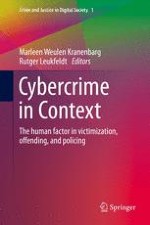2021 | OriginalPaper | Buchkapitel
Text Mining for Cybercrime in Registrations of the Dutch Police
verfasst von : André M. van der Laan, Nikolaj Tollenaar
Erschienen in: Cybercrime in Context
Verlag: Springer International Publishing
Aktivieren Sie unsere intelligente Suche, um passende Fachinhalte oder Patente zu finden.
Wählen Sie Textabschnitte aus um mit Künstlicher Intelligenz passenden Patente zu finden. powered by
Markieren Sie Textabschnitte, um KI-gestützt weitere passende Inhalte zu finden. powered by
